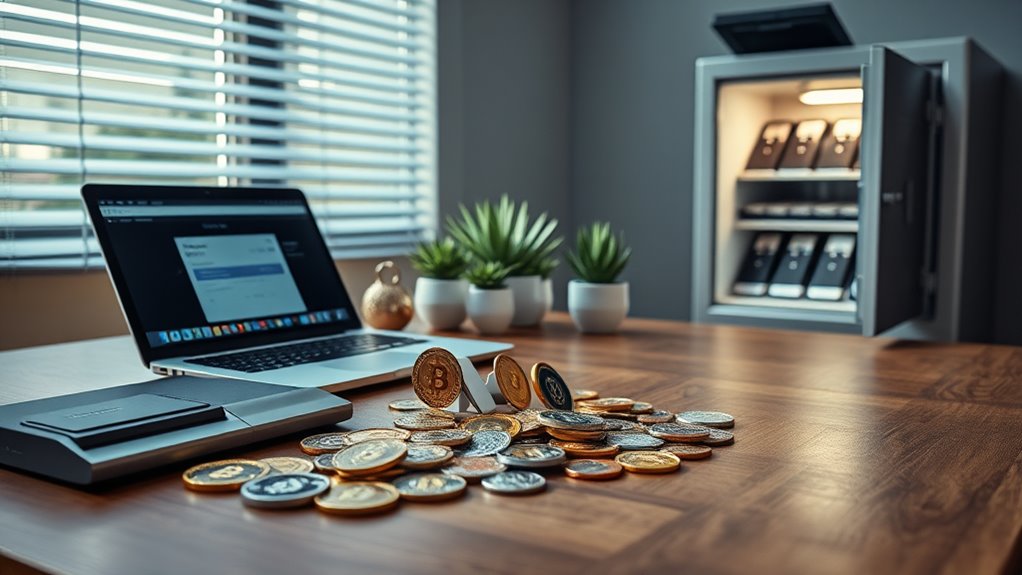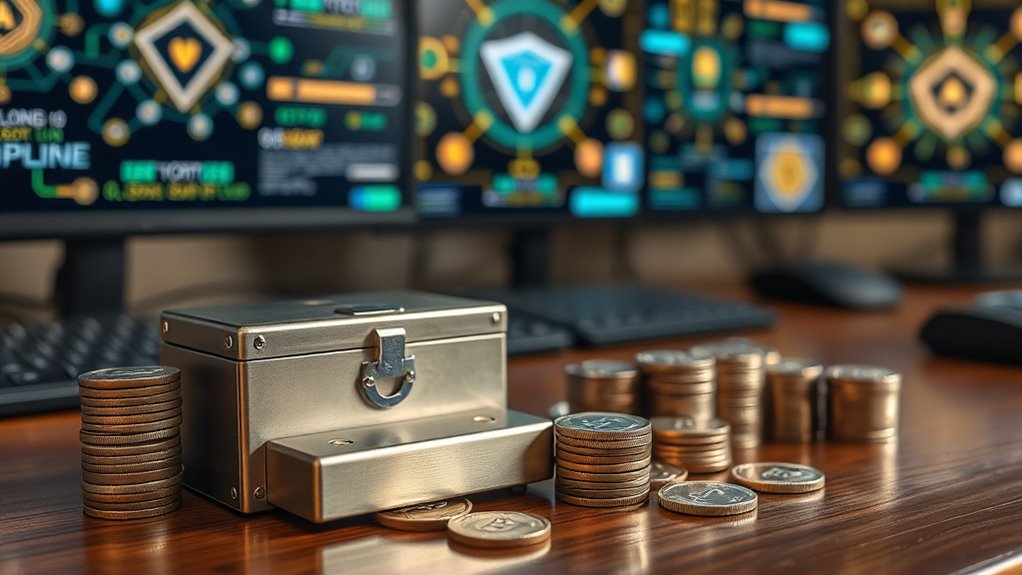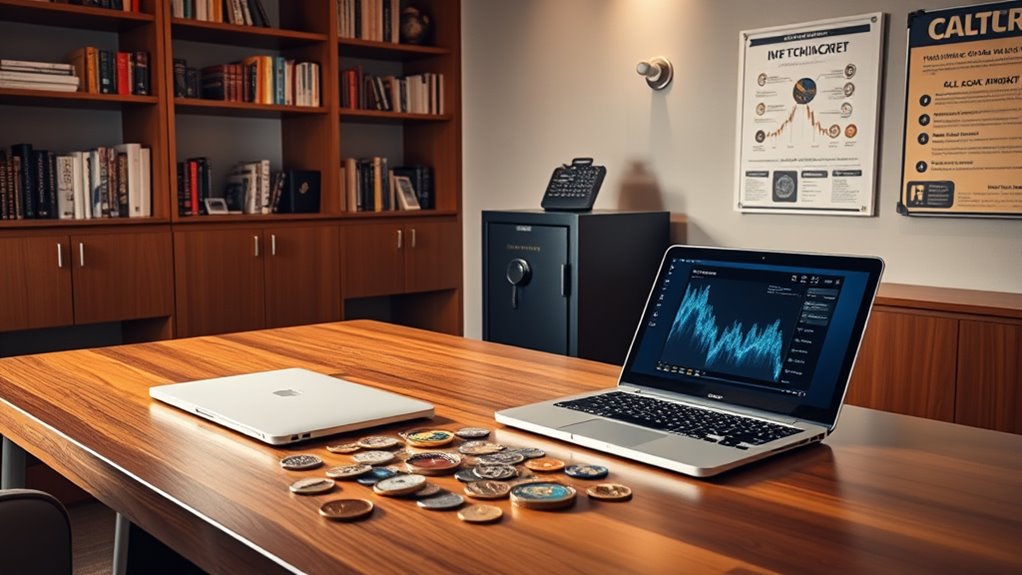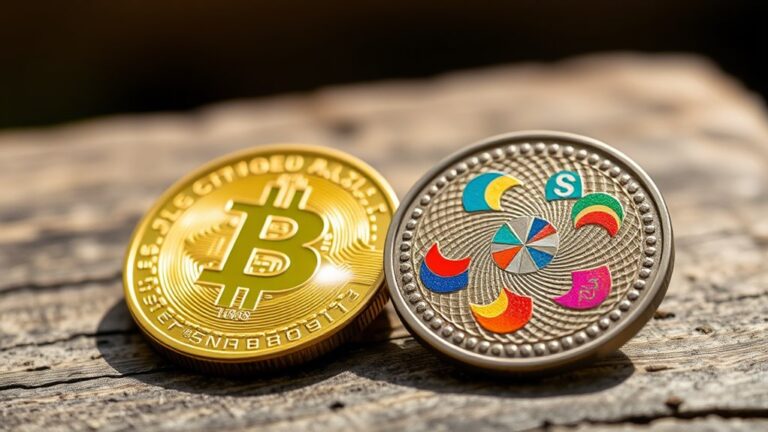
How to Store and Secure Altcoins: A Beginner’s Guide
Altcoins are stored in wallets, with hot wallets offering convenience for frequent trades, while cold storage provides increased security against online threats. Cold storage methods, like hardware wallets, keep private keys offline and secure. Employ best practices such as using two-factor authentication, strong passwords, and updated software. Be mindful of altcoin risks like volatility and regulatory uncertainty. Safe transfers require careful attention to platform security and transaction details. Continue to discover effective strategies for altcoin security.
Key Takeaways
- Use a combination of hot wallets for accessibility and cold storage for enhanced security.
- Safeguard cryptocurrencies with hardware wallets like Ledger Nano S to store private keys offline.
- Enable two-factor authentication (2FA) for added security on hot wallets.
- Regularly update wallet software and utilize strong, unique passwords with a password manager.
- Conduct test transactions and verify details to ensure safe and accurate altcoin transfers.
Exploring Wallet Types and Features

When it comes to storing and securing altcoins, understanding the various wallet types and their features is crucial.
Hot wallets are a notable type, known for their convenience and accessibility due to their constant online presence. This feature makes them ideal for frequent transactions and active trading. They often support multiple cryptocurrencies, making them suitable for managing diverse portfolios.
Hot wallets offer unmatched convenience and accessibility for active trading and managing diverse cryptocurrency portfolios.
Hot wallets can integrate with decentralized applications, like Trust and Coinbase, enhancing their functionality within the crypto ecosystem. Despite their user-friendly interfaces and features such as built-in exchanges and biometric authentication, they carry security risks due to potential cyber threats. Newcomers should pay attention to important considerations like security features, ease of use, supported cryptocurrencies, and cost when selecting a wallet.
For thorough altcoin management, knowing the distinctions among software, mobile, desktop, and web wallets is important for users seeking convenience and security.
Delving Into the Security of Cold Storage

After exploring the different types and features of hot wallets, understanding cold storage becomes important for those seeking enhanced security for their altcoins.
Cold storage refers to keeping cryptocurrencies offline, effectively shielding them from online threats like hacking. Its primary advantage is enhanced security, as it removes digital assets from vulnerable internet environments.
Devices such as hardware wallets and paper wallets are key components in this security-centric approach. Hardware wallets like Ledger Nano S store private keys offline, while paper wallets offer low-tech security solutions by printing keys on paper.
Unlike hot wallets, cold storage provides long-term safety and reduces hacking risks by requiring physical access. Many investors favor cold storage for its robust security, mitigating loss through theft or malfunction.
Moreover, it is recommended to implement multi-signature protection as an additional security measure, ensuring that multiple approvals are necessary for transactions, further reducing the risk of unauthorized access.
Implementing Best Practices for Altcoin Security

Guaranteeing the security of altcoins is a critical aspect for any investor, given the evolving threats in the digital landscape.
To implement best practices, using cold storage devices such as hardware wallets guarantees altcoins remain offline and secure from online threats. Hot wallets, while convenient, require robust security measures like two-factor authentication (2FA) and the use of complex, unique passwords managed with reliable password managers.
Regular software updates and secured key management—keeping private keys safe and unshared—are essential. Additionally, securing one’s network with a reliable internet connection, antivirus software, and firewalls further protects altcoin investments.
Enhancing wallet security through multisignature wallets and regular backups prevents unauthorized access and data loss, safeguarding investors’ digital assets thoroughly. It is also imperative to be vigilant against online threats by staying informed about phishing awareness to avoid falling victim to scams and fraudulent schemes.
Understanding Risks Associated With Altcoin Investment

While investing in altcoins can be appealing due to their potential for high returns, it is essential to recognize the associated risks that accompany these investments.
Market conditions play a major role, as altcoins are subject to volatility, leading to unpredictable price changes. Regulatory announcements can also greatly shift their prices, contributing to a fluctuating market sentiment.
Investors face security threats, such as hacking incidents and scams, which pose serious risks to their investments. The lack of clear regulations adds to the uncertainty, as policies can abruptly change, impacting altcoin legality.
Additionally, technological risks from unstable blockchain technologies and poor smart contract implementation introduce further challenges.
Moreover, the prevalence of scams in the altcoin market emphasizes the need for thorough research before making investment decisions. Hence, understanding these risks is vital for any prospective altcoin investor.
Navigating Safe Altcoin Transfers

When steering safe altcoin transfers, it is essential to understand the fundamental steps and precautions one must take to guarantee a secure transaction. Selecting a secure platform with robust security measures, such as two-factor authentication, is foundational.
Choosing between hot and cold wallets depends on the user’s storage needs and trade-off between convenience and security. Network compatibility guarantees the recipient’s wallet supports the altcoin’s blockchain.
To manage transaction fees, awareness of the fee structure and optimization based on timing and size is necessary. Verifying transaction details, confirming the wallet address, and understanding the blockchain network are all critical for successful transfers. Consider test transactions to mitigate risks.
Understanding cryptocurrency wallets involves recognizing that these digital tools provide secure storage for private keys, enabling safe access and management of your altcoins.
Frequently Asked Questions
How Do I Choose a Reliable Altcoin Exchange Platform?
Choosing a reliable altcoin exchange involves evaluating factors like available cryptocurrencies, security measures, fee structures, regulatory compliance, user interface quality, trading tools, mobile access, educational resources, wallet services, and customer support. Consider the exchange’s security protocols and reputation.
Are There Tax Implications for Trading or Holding Altcoins?
Trading or holding altcoins carries various tax implications. Capital gains tax applies when altcoins are sold or traded, and income tax is relevant for earnings through mining or staking. Accurate reporting and compliance are essential to avoid penalties.
Can Altcoins Be Anonymously Traded or Held?
Approximately 60% of crypto users utilize privacy tools for anonymity. Altcoins can be anonymously traded via decentralized exchanges or P2P platforms, while off-exchange storage and hardware wallets allow secure altcoin holding without personal information exposure.
What Are the Typical Fees Involved in Altcoin Transactions?
Altcoin transaction fees vary widely, influenced by network demand, transaction size, and specific altcoin architecture. Typically, they include network fees, wallet fees, and platform fees, with structures like fixed, percentage-based, and dynamically adjustable fees prevailing.
How Can I Track the Performance of My Altcoin Investments?
Tracking altcoin performance is like unraveling the mysteries of the universe. Utilizing tools like portfolio trackers, altcoin season index, and custom alerts can offer unparalleled insights, empowering investors to make informed decisions and navigate market fluctuations effortlessly.
Conclusion
In the domain of storing and securing altcoins, a confluence of technology and vigilance becomes apparent. As beginners explore various wallet types and the reliability of cold storage, they inevitably confront the risks that accompany altcoin investment. By implementing best practices and understanding safe transfer techniques, one coincidentally finds that security is not just about technology but also about informed decision-making. Ultimately, protecting altcoins requires a careful blend of knowledge, strategy, and caution.












